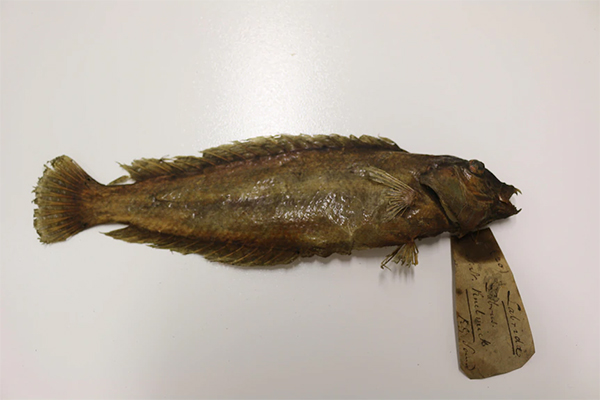One of the preserved fish — Chironemus maculosus — caught in the fish traps at Oyster Harbour 130 years ago.(Supplied: National Museums Scotland).
Lauren Smith, Historical fish collection sheds light on Aboriginal fishing methods, ABC Great Southern, 30 November 2022
Experts hope a new project will recognise the contribution of traditional owners to fish science dating back thousands of years on Western Australia’s south coast.
Key points:
- Historic fish traps built by the Menang Noongar people on WA’s south coast are thought to be 7,000 years old
- In 1839, European explorer Robert Neill ventured to Albany and collected fish specimens
- The 180-year-old dried fish have since been displayed at both the Natural History Museum in London and the National Museum of Scotland
Historical fish traps built by the Menang Noongar people are estimated to be around 7,000 years old.
In 1839, European explorer Robert Neill ventured into the area and curated a collection of fish specimens.
The 180-year-old dried fish have since been displayed at both the Natural History Museum in London and the National Museum of Scotland.
Shona Coyne, a Menang woman, senior curator and manager of repatriation and community engagement at the National Museum of Australia, said many locals were familiar with Robert Neill’s paintings of the traps.
“I think a project like this will help reveal some of the Menang knowledge that’s encapsulated in these paintings,” she said.

Ms Coyne said traditional names for the fish would be allocated in museum catalogues following consultation with Menang representatives.
“There is actually one special fish, we like to call it the hero fish, and that actually had a Menang name, which is Paril,” she said.
“That name has gone into the scientific taxonomy name, which is incredibly rare.”
Ms Coyne said Indigenous people have been contributing to the collection of specimens for many years, but local knowledge had never before been recognised in the scientific nomenclature.

Recognising Indigenous fishers
Deakin University associate professor Tiffany Shellam said curators at both museums were keen to update their database to honour Menang people’s involvement in the collection.
“At the moment, these collections are framed as purely western science collections, they’re natural history collections in the eyes of the museum,” Dr Shellam said.
“But we know they are rich cultural objects too and they have this tangible connection back to country.”
Dr Shellam said they were an amazing example of early cross-cultural relationships between Robert Neill and the Menang people and the knowledge they shared with him.
She said it was amazing how many specimens had survived with many still to be fully identified.

“We think that he [Robert Neill] collected around 50 specimens,” she said.
National Museum of Scotland curator Andrew Kitchener said while they had known of the specimens for more than 60 years, they did not completely understand the extent of Menang people’s involvement.
“We’ve had this collection of dried fishes since the 1960s,” Dr Kitchener said.
“They were among the first Australian fishes of their kind ever to be known to western science.”
While not pretty to look at, Dr Kitchener said they remained an incredibly important part of natural history, and hoped the museum could build on the collection.
“We are going to be working with the Western Australian Museum and the Menang people in Albany in order to create a modern collection of fishes from the sea,” he said.
“We hope to bring [them] back to Edinburgh to have this 180-year gap filled with new specimens in our collection.”

